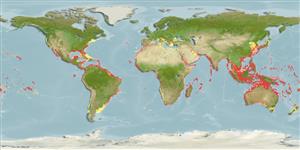>
Carangiformes (Jacks) >
Echeneidae (Remoras)
Etymology: Echeneis: Greek, echein = to hold + Greek, nays = ship; remora, suckling fish; 1774 (Ref. 45335).
More on author: Linnaeus.
Environment: milieu / climate zone / depth range / distribution range
Ecologia
marinhas; estuarina associadas(os) a recifes; intervalo de profundidade 1 - 85 m (Ref. 86942). Subtropical; 45°N - 45°S, 180°W - 180°E
Circumtropical.
Tamanho / Peso / Idade
Maturity: Lm ? range ? - ? cm
Max length : 110 cm TL macho/indeterminado; (Ref. 9710); common length : 66.0 cm SL macho/indeterminado; (Ref. 10970); peso máx. publicado: 2.3 kg (Ref. 40637)
Espinhos dorsais (total): 0; Raios dorsais (total): 32-42; Espinhos anais 0; Raios anais : 29 - 41.
Most abundant remora in warm waters (Ref. 4389). Occurs near as well as far from the coast (Ref. 5217). Often found free-swimming in shallow inshore areas and around coral reefs (Ref. 26938). Attaches temporarily to a variety of hosts including sharks, rays, large bony fishes or sea turtles, whales, dolphins and also to ships. May follow divers (Ref. 9710); reported to attach itself to a diver's leg (Ref. 57809). Feeds on small fishes, bits of its host's prey and host's parasites (Ref. 26938). Juveniles occasionally act as reef station-based cleaners, where they service parrotfishes (Ref. 40095). Sometimes used by natives to aid in fishing; a line is tied to the caudal peduncle of the remora and then is released; upon attaching to another fish, the remora and its host are hauled in by the fisher (Ref. 9682).
Ciclo de vida ou comportamento de acasalamento
Maturidade | Reprodução | Desova | Ovos | Fecundidade | Larvas
Paxton, J.R., D.F. Hoese, G.R. Allen and J.E. Hanley, 1989. Pisces. Petromyzontidae to Carangidae. Zoological Catalogue of Australia, Vol. 7. Australian Government Publishing Service, Canberra, 665 p. (Ref. 7300)
Status na Lista Vermelha da UICN (Ref. 130435)
Ameaça para os humanos
Harmless
Uso pelos humanos
Pescarias: pouco comercial; peixe esportivo: sim; Aquário: Espécies comerciais
Mais informação
ReferênciasAquaculturaPerfil para aquaculturaEstirpesGenéticaElectrophoresesHereditariedadeDoençasProcessamentoNutrientsConversão de massa
Ferramentas
Relatórios especiais
Baixar XML
Fontes da internet
Estimates based on models
Preferred temperature (Ref.
123201): 18.3 - 28.6, mean 27.2 °C (based on 566 cells).
Índice de diversidade filogenética (Ref.
82804): PD
50 = 0.7539 [Uniqueness, from 0.5 = low to 2.0 = high].
Bayesian length-weight: a=0.00263 (0.00112 - 0.00620), b=3.17 (2.96 - 3.38), in cm total length, based on LWR estimates for this (Sub)family-body shape (Ref.
93245).
Nível Trófico (Ref.
69278): 3.7 ±0.3 se; based on diet studies.
Resiliência (Ref.
120179): médio(a), tempo mínimo de duplicação da população 1,4 - 4,4 anos (Assuming Fec < 10,000).
Fishing Vulnerability (Ref.
59153): High to very high vulnerability (66 of 100).
Nutrients (Ref.
124155): Calcium = 22.5 [10.7, 37.1] mg/100g; Iron = 0.59 [0.32, 0.99] mg/100g; Protein = 19.8 [18.7, 20.8] %; Omega3 = 0.128 [0.068, 0.250] g/100g; Selenium = 28.3 [13.0, 54.4] μg/100g; VitaminA = 25.8 [8.3, 87.1] μg/100g; Zinc = 0.702 [0.456, 1.085] mg/100g (wet weight);
